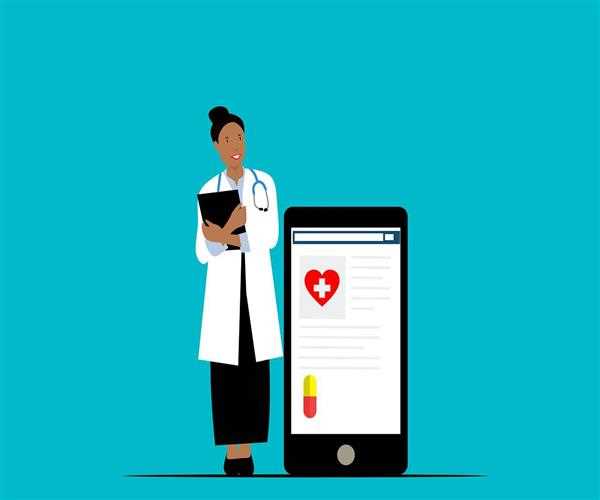According to GSMA real-time intelligence data, as of August 2019, 5.13 billion people worldwide had mobile devices. This indicates that 66.53% of the world's population use mobile devices (cell phones, tablets, or cellular-enabled IoT device).
In the United States, 71.5 percent of the population owns a mobile smartphone. The fascination with 'ding' objects among Americans has led to many new ways of connecting, monitoring, remembering, and caring for patients. Mobile Health Technology, often referred to as mHealth, allows patients to consult their physician, log in to the patient portal, calculate their steps and glucose levels, initiate telehealth travel, and manage their medications and illnesses. The preferred way to maintain. And the fact that patients are at the forefront of the mHealth app and platform revolution raises excitement.
Here are five benefits of mobile health technology.
1. Allows patients to access physicians and receive care more quickly.
Unlike inefficient phone access to physicians and health care providers, mobile health technology allows patients to stay in touch with physicians 24 hours a day, seven days a week for secure messaging, appointments, and telemedicine visits. Telemedicine is one of the most popular ways for patients to access the mHealth app on their smartphones. They like how easy it is to visit a provider on their phone or tablet and they do not have to go to the doctor's office or take a break from work. In response to increased demand, many healthcare systems offer telemedicine visits on the hours and weekends from network physicians and contract telehealth practitioners.
2. Improved drug adherence.
It is difficult to keep track of whether patients are taking their medication after being discharged from the hospital or clinic. Or, to be honest, even if they take it from ********. Poor medication adherence is the main reason for poor management of a patient’s chronic disease. It can also lead to hospitalization and bad results.
The mHealth application and mobile technology solution help patients take their prescriptions accurately by providing instructional content along with features such as automated medications and refill reminders.
There are thousands of applications available to help people remember to take their medicine. In a previous column, I mentioned six top medicine adherence apps that remind patients of their medications.
3. Enables and facilitates remote patient monitoring.
Patients can use mobile devices and mobile health technology to receive, record, or automatically collect health data and transmit it to health care providers via remote patient monitoring, which is used for home care and telehealth is a sub-genre.
The ability to track a patient's condition between visits and to alert the physician or caregiver when a patient's biological data may endanger them is an important step in care management. Without mobile devices and mobile health technologies, especially wearable devices such as watches, fitness trackers, and wristbands, continuous recording and monitoring of such data would be cumbersome or impossible.
The most common application of remote patient monitoring is to assist patients in managing a chronic illness or to check if they are following their hospital discharge instructions and taking their prescriptions appropriately. The following are examples of data types being transmitted via mobile devices:
- Monitors weight, blood pressure, and heart rate
- Glucose meters are devices that measure the amount of glucose in the blood.
- Datalogger for food
With the introduction of new codes by Medicare and Medicaid Services (CMS) in 2019, remote patient monitoring will gain momentum and enable physicians and healthcare companies to generate new revenue streams for these services.
4. Improves patient safety by increasing drug solution accuracy.
Most patients do not remember the names or dosages of the medications they are taking, which is common information. This is especially difficult for patients with polypharmacy (those who take more than five prescription drugs daily), the elderly, and other high-risk patients.
Many patients (and their caregivers or family members) are at risk because they cannot reliably remember their medication list to the doctor, ED taking, or the nurse or other professional who arrives at the hospital. Drug-to-drug interactions are possible when physicians are not sure what medication the patient is taking. Adverse drug reactions can occur when a patient is hospitalized, not given a prescription for what she should take, but also fails to provide information.
By filling this information gap, the curator hopes to improve patient safety and medication management. The Curator Meds 360 system provides physicians and other professionals with a bird's eye view of all medications prescribed to the patient, including pick-up and refill history, dose changes, and more.
5. Improves provider coordination and communication.
Many physicians find it difficult to connect with coworkers, co-workers, and patients because of packaged appointment calendars, longer days, and coverage requirements for different facilities. Using encrypted messaging and texting, mobile health record access, and cellular phone conversations, mobile health technology enhances the ability to communicate with referral physicians and office workers throughout the entire health care system.
Patients in need of medical treatment or hospitalization can be alerted through the mHealth application. The curator is influencing mobile health tools such as clinical event notifications to improve care transition. The platform makes it easy to see a complete picture of the patient - where they are, who treated them, why, and where they are going - so they can make informed decisions.
Providers get real-time notifications on their mobile devices on patient ED arrivals, admissions, discharges, and transfers as part of the Creator solution. Clinical checklists are also prompted by warnings that help to standardize and streamline care on a case-by-case basis.
Mobile health technology's advantages continue to grow and change. Given the widespread availability of mobile devices in the United States and patients' enthusiasm for utilizing them to manage their conditions and health, it's conceivable that these technologies will be prescribed and utilized more frequently in the future. We'll start to observe new and positive effects on health outcomes as mHealth applications become more incorporated into the treatment continuum.




Leave Comment